Operation Management Report: Leadership & Management in Sainsbury's
VerifiedAdded on 2021/02/21
|10
|2536
|49
Report
AI Summary
This report delves into operation management, focusing on leadership and management principles within the context of Sainsbury's. It explores the roles and characteristics of both leaders and managers, differentiating their functions and responsibilities. The report analyzes various leadership theories, including situational and contingency leadership, evaluating their strengths and weaknesses. A significant portion of the report examines the application of these theories in different situational contexts within Sainsbury's, such as employee engagement, technological advancements, and decision-making processes. The report highlights the importance of adapting leadership styles to specific situations and discusses the benefits and drawbacks of each approach, ultimately concluding with recommendations for effective leadership practices in the retail environment. The report provides a comprehensive overview of leadership management and its impact on organizational success.
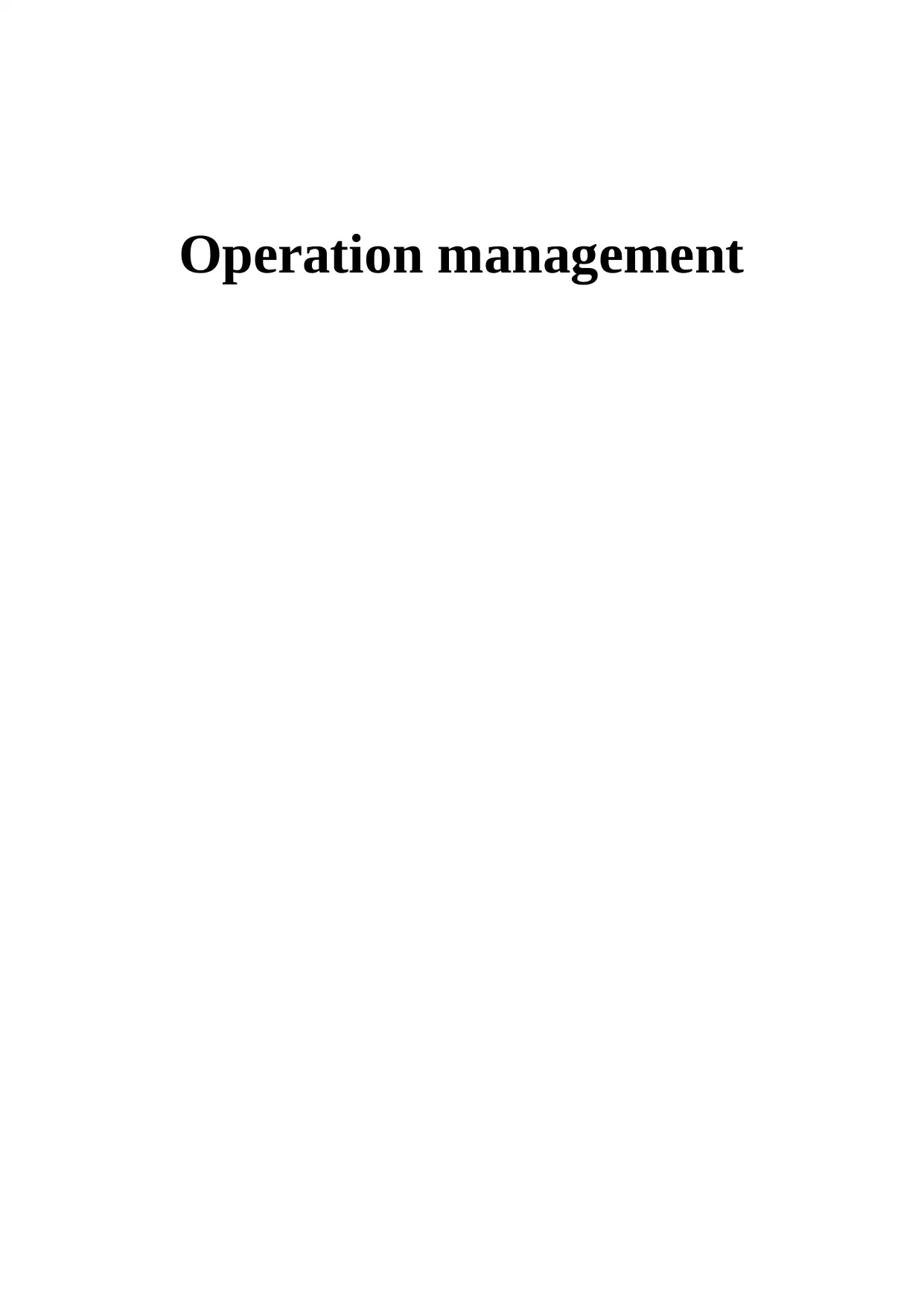
Operation management
Paraphrase This Document
Need a fresh take? Get an instant paraphrase of this document with our AI Paraphraser
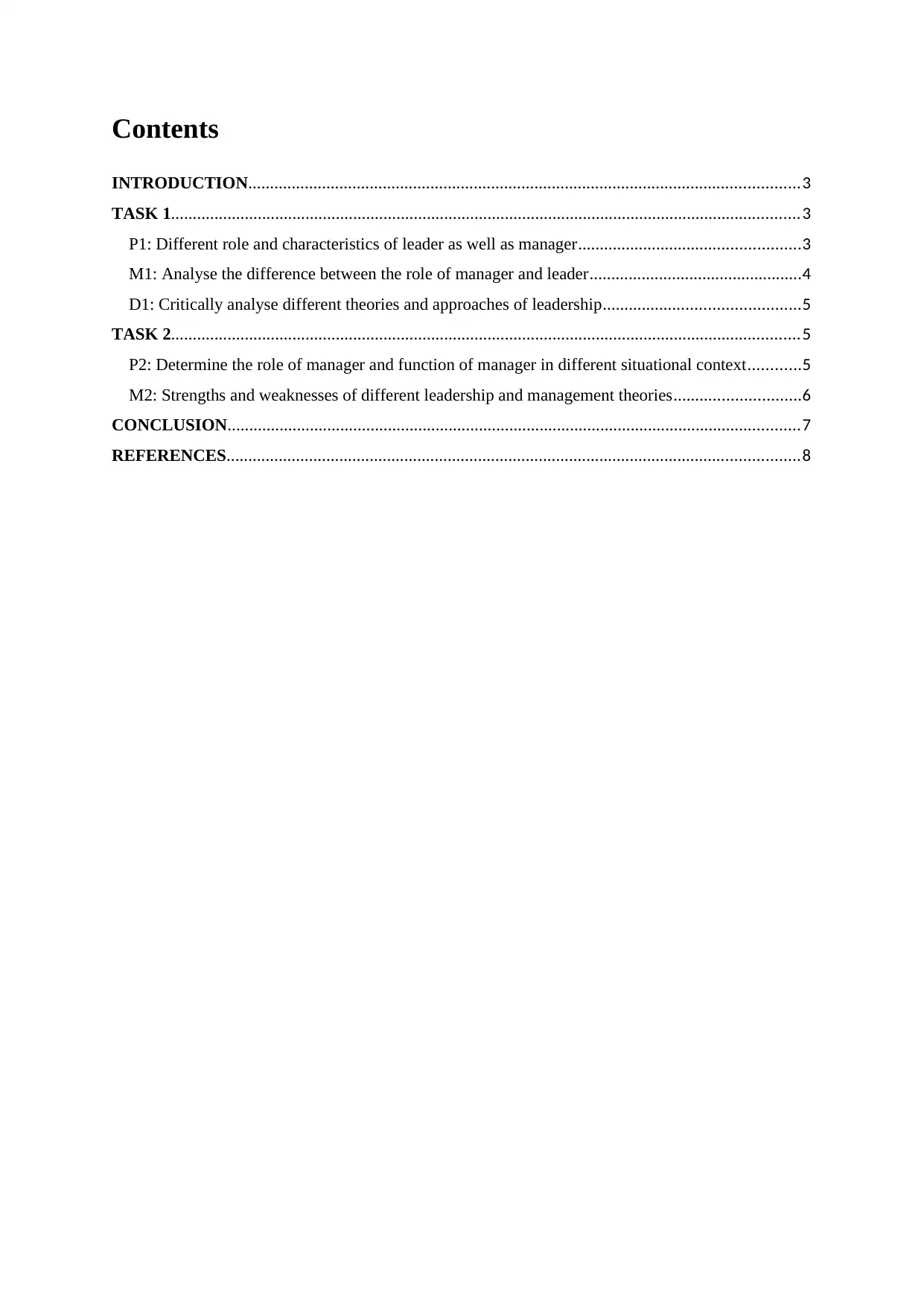
Contents
INTRODUCTION...............................................................................................................................3
TASK 1.................................................................................................................................................3
P1: Different role and characteristics of leader as well as manager...................................................3
M1: Analyse the difference between the role of manager and leader.................................................4
D1: Critically analyse different theories and approaches of leadership.............................................5
TASK 2.................................................................................................................................................5
P2: Determine the role of manager and function of manager in different situational context............5
M2: Strengths and weaknesses of different leadership and management theories.............................6
CONCLUSION....................................................................................................................................7
REFERENCES....................................................................................................................................8
INTRODUCTION...............................................................................................................................3
TASK 1.................................................................................................................................................3
P1: Different role and characteristics of leader as well as manager...................................................3
M1: Analyse the difference between the role of manager and leader.................................................4
D1: Critically analyse different theories and approaches of leadership.............................................5
TASK 2.................................................................................................................................................5
P2: Determine the role of manager and function of manager in different situational context............5
M2: Strengths and weaknesses of different leadership and management theories.............................6
CONCLUSION....................................................................................................................................7
REFERENCES....................................................................................................................................8
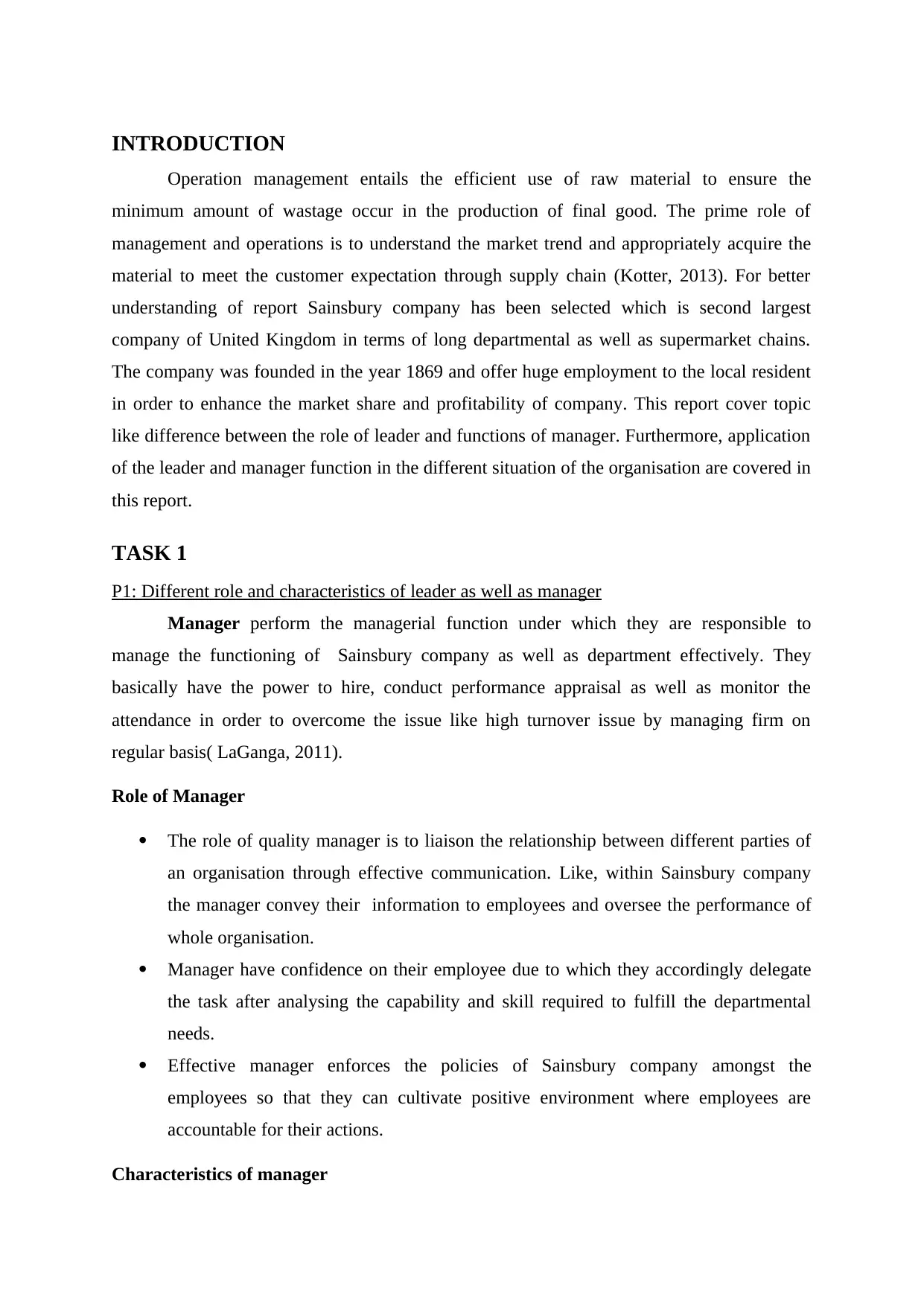
INTRODUCTION
Operation management entails the efficient use of raw material to ensure the
minimum amount of wastage occur in the production of final good. The prime role of
management and operations is to understand the market trend and appropriately acquire the
material to meet the customer expectation through supply chain (Kotter, 2013). For better
understanding of report Sainsbury company has been selected which is second largest
company of United Kingdom in terms of long departmental as well as supermarket chains.
The company was founded in the year 1869 and offer huge employment to the local resident
in order to enhance the market share and profitability of company. This report cover topic
like difference between the role of leader and functions of manager. Furthermore, application
of the leader and manager function in the different situation of the organisation are covered in
this report.
TASK 1
P1: Different role and characteristics of leader as well as manager
Manager perform the managerial function under which they are responsible to
manage the functioning of Sainsbury company as well as department effectively. They
basically have the power to hire, conduct performance appraisal as well as monitor the
attendance in order to overcome the issue like high turnover issue by managing firm on
regular basis( LaGanga, 2011).
Role of Manager
The role of quality manager is to liaison the relationship between different parties of
an organisation through effective communication. Like, within Sainsbury company
the manager convey their information to employees and oversee the performance of
whole organisation.
Manager have confidence on their employee due to which they accordingly delegate
the task after analysing the capability and skill required to fulfill the departmental
needs.
Effective manager enforces the policies of Sainsbury company amongst the
employees so that they can cultivate positive environment where employees are
accountable for their actions.
Characteristics of manager
Operation management entails the efficient use of raw material to ensure the
minimum amount of wastage occur in the production of final good. The prime role of
management and operations is to understand the market trend and appropriately acquire the
material to meet the customer expectation through supply chain (Kotter, 2013). For better
understanding of report Sainsbury company has been selected which is second largest
company of United Kingdom in terms of long departmental as well as supermarket chains.
The company was founded in the year 1869 and offer huge employment to the local resident
in order to enhance the market share and profitability of company. This report cover topic
like difference between the role of leader and functions of manager. Furthermore, application
of the leader and manager function in the different situation of the organisation are covered in
this report.
TASK 1
P1: Different role and characteristics of leader as well as manager
Manager perform the managerial function under which they are responsible to
manage the functioning of Sainsbury company as well as department effectively. They
basically have the power to hire, conduct performance appraisal as well as monitor the
attendance in order to overcome the issue like high turnover issue by managing firm on
regular basis( LaGanga, 2011).
Role of Manager
The role of quality manager is to liaison the relationship between different parties of
an organisation through effective communication. Like, within Sainsbury company
the manager convey their information to employees and oversee the performance of
whole organisation.
Manager have confidence on their employee due to which they accordingly delegate
the task after analysing the capability and skill required to fulfill the departmental
needs.
Effective manager enforces the policies of Sainsbury company amongst the
employees so that they can cultivate positive environment where employees are
accountable for their actions.
Characteristics of manager
⊘ This is a preview!⊘
Do you want full access?
Subscribe today to unlock all pages.

Trusted by 1+ million students worldwide
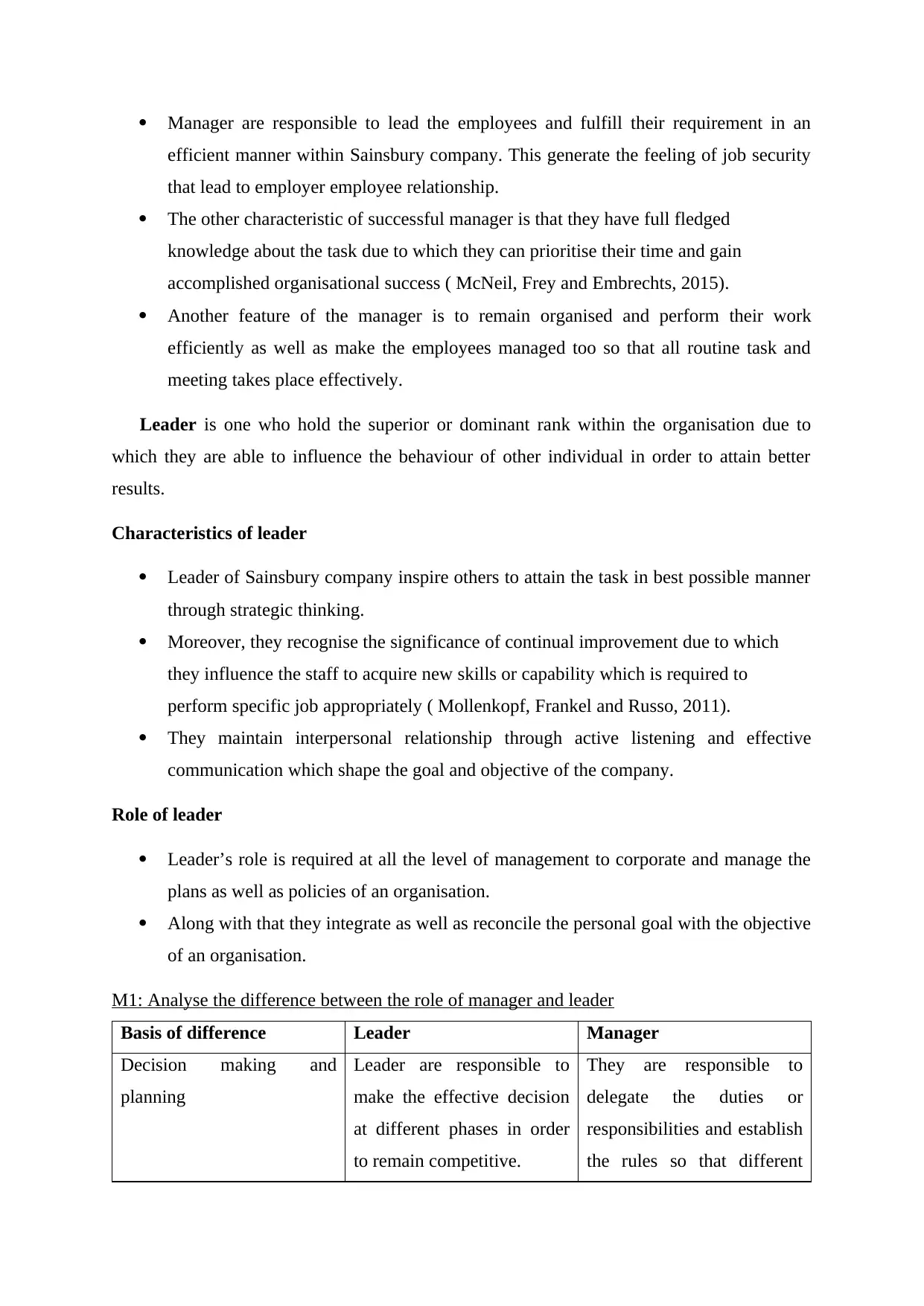
Manager are responsible to lead the employees and fulfill their requirement in an
efficient manner within Sainsbury company. This generate the feeling of job security
that lead to employer employee relationship.
The other characteristic of successful manager is that they have full fledged
knowledge about the task due to which they can prioritise their time and gain
accomplished organisational success ( McNeil, Frey and Embrechts, 2015).
Another feature of the manager is to remain organised and perform their work
efficiently as well as make the employees managed too so that all routine task and
meeting takes place effectively.
Leader is one who hold the superior or dominant rank within the organisation due to
which they are able to influence the behaviour of other individual in order to attain better
results.
Characteristics of leader
Leader of Sainsbury company inspire others to attain the task in best possible manner
through strategic thinking.
Moreover, they recognise the significance of continual improvement due to which
they influence the staff to acquire new skills or capability which is required to
perform specific job appropriately ( Mollenkopf, Frankel and Russo, 2011).
They maintain interpersonal relationship through active listening and effective
communication which shape the goal and objective of the company.
Role of leader
Leader’s role is required at all the level of management to corporate and manage the
plans as well as policies of an organisation.
Along with that they integrate as well as reconcile the personal goal with the objective
of an organisation.
M1: Analyse the difference between the role of manager and leader
Basis of difference Leader Manager
Decision making and
planning
Leader are responsible to
make the effective decision
at different phases in order
to remain competitive.
They are responsible to
delegate the duties or
responsibilities and establish
the rules so that different
efficient manner within Sainsbury company. This generate the feeling of job security
that lead to employer employee relationship.
The other characteristic of successful manager is that they have full fledged
knowledge about the task due to which they can prioritise their time and gain
accomplished organisational success ( McNeil, Frey and Embrechts, 2015).
Another feature of the manager is to remain organised and perform their work
efficiently as well as make the employees managed too so that all routine task and
meeting takes place effectively.
Leader is one who hold the superior or dominant rank within the organisation due to
which they are able to influence the behaviour of other individual in order to attain better
results.
Characteristics of leader
Leader of Sainsbury company inspire others to attain the task in best possible manner
through strategic thinking.
Moreover, they recognise the significance of continual improvement due to which
they influence the staff to acquire new skills or capability which is required to
perform specific job appropriately ( Mollenkopf, Frankel and Russo, 2011).
They maintain interpersonal relationship through active listening and effective
communication which shape the goal and objective of the company.
Role of leader
Leader’s role is required at all the level of management to corporate and manage the
plans as well as policies of an organisation.
Along with that they integrate as well as reconcile the personal goal with the objective
of an organisation.
M1: Analyse the difference between the role of manager and leader
Basis of difference Leader Manager
Decision making and
planning
Leader are responsible to
make the effective decision
at different phases in order
to remain competitive.
They are responsible to
delegate the duties or
responsibilities and establish
the rules so that different
Paraphrase This Document
Need a fresh take? Get an instant paraphrase of this document with our AI Paraphraser
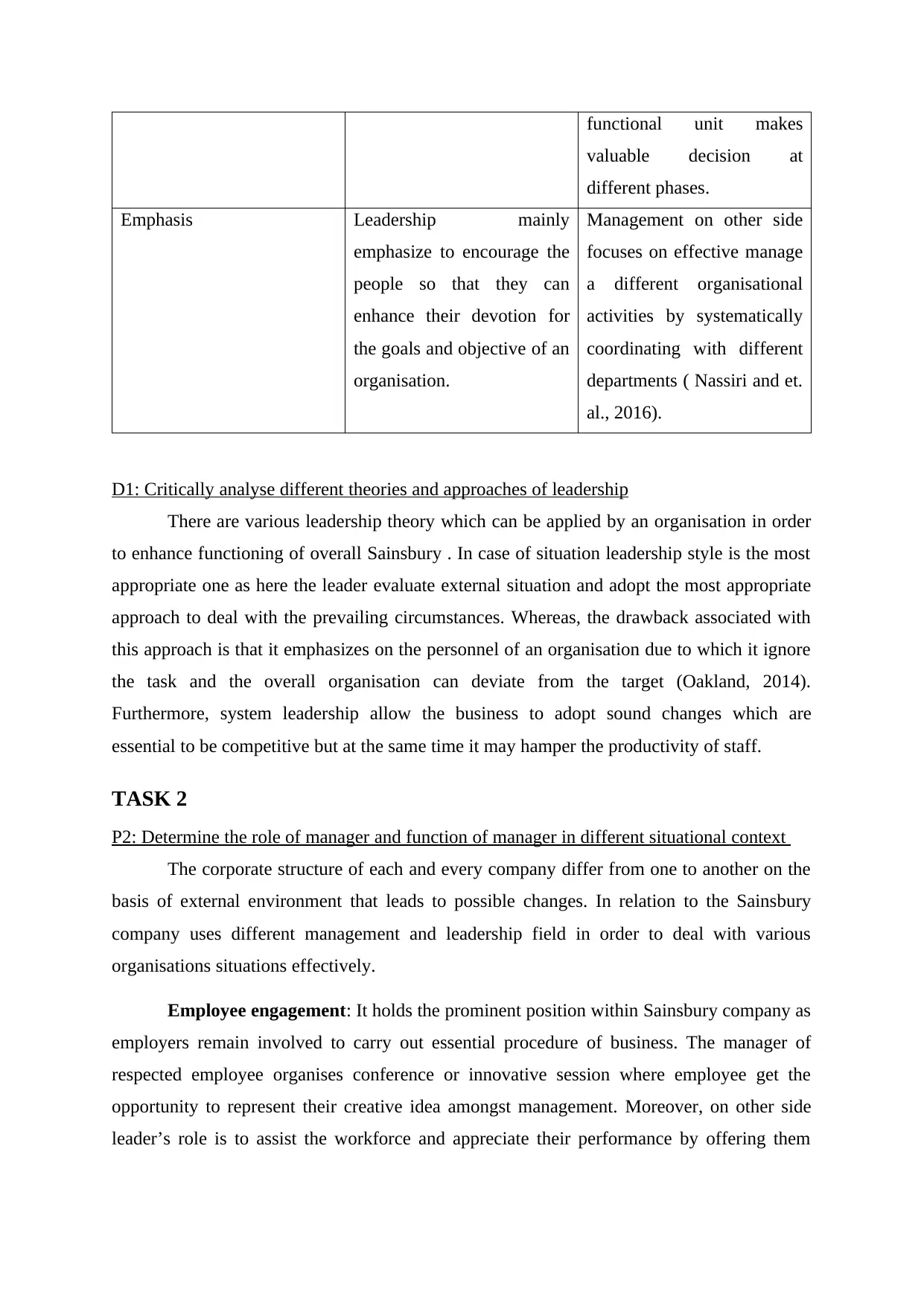
functional unit makes
valuable decision at
different phases.
Emphasis Leadership mainly
emphasize to encourage the
people so that they can
enhance their devotion for
the goals and objective of an
organisation.
Management on other side
focuses on effective manage
a different organisational
activities by systematically
coordinating with different
departments ( Nassiri and et.
al., 2016).
D1: Critically analyse different theories and approaches of leadership
There are various leadership theory which can be applied by an organisation in order
to enhance functioning of overall Sainsbury . In case of situation leadership style is the most
appropriate one as here the leader evaluate external situation and adopt the most appropriate
approach to deal with the prevailing circumstances. Whereas, the drawback associated with
this approach is that it emphasizes on the personnel of an organisation due to which it ignore
the task and the overall organisation can deviate from the target (Oakland, 2014).
Furthermore, system leadership allow the business to adopt sound changes which are
essential to be competitive but at the same time it may hamper the productivity of staff.
TASK 2
P2: Determine the role of manager and function of manager in different situational context
The corporate structure of each and every company differ from one to another on the
basis of external environment that leads to possible changes. In relation to the Sainsbury
company uses different management and leadership field in order to deal with various
organisations situations effectively.
Employee engagement: It holds the prominent position within Sainsbury company as
employers remain involved to carry out essential procedure of business. The manager of
respected employee organises conference or innovative session where employee get the
opportunity to represent their creative idea amongst management. Moreover, on other side
leader’s role is to assist the workforce and appreciate their performance by offering them
valuable decision at
different phases.
Emphasis Leadership mainly
emphasize to encourage the
people so that they can
enhance their devotion for
the goals and objective of an
organisation.
Management on other side
focuses on effective manage
a different organisational
activities by systematically
coordinating with different
departments ( Nassiri and et.
al., 2016).
D1: Critically analyse different theories and approaches of leadership
There are various leadership theory which can be applied by an organisation in order
to enhance functioning of overall Sainsbury . In case of situation leadership style is the most
appropriate one as here the leader evaluate external situation and adopt the most appropriate
approach to deal with the prevailing circumstances. Whereas, the drawback associated with
this approach is that it emphasizes on the personnel of an organisation due to which it ignore
the task and the overall organisation can deviate from the target (Oakland, 2014).
Furthermore, system leadership allow the business to adopt sound changes which are
essential to be competitive but at the same time it may hamper the productivity of staff.
TASK 2
P2: Determine the role of manager and function of manager in different situational context
The corporate structure of each and every company differ from one to another on the
basis of external environment that leads to possible changes. In relation to the Sainsbury
company uses different management and leadership field in order to deal with various
organisations situations effectively.
Employee engagement: It holds the prominent position within Sainsbury company as
employers remain involved to carry out essential procedure of business. The manager of
respected employee organises conference or innovative session where employee get the
opportunity to represent their creative idea amongst management. Moreover, on other side
leader’s role is to assist the workforce and appreciate their performance by offering them
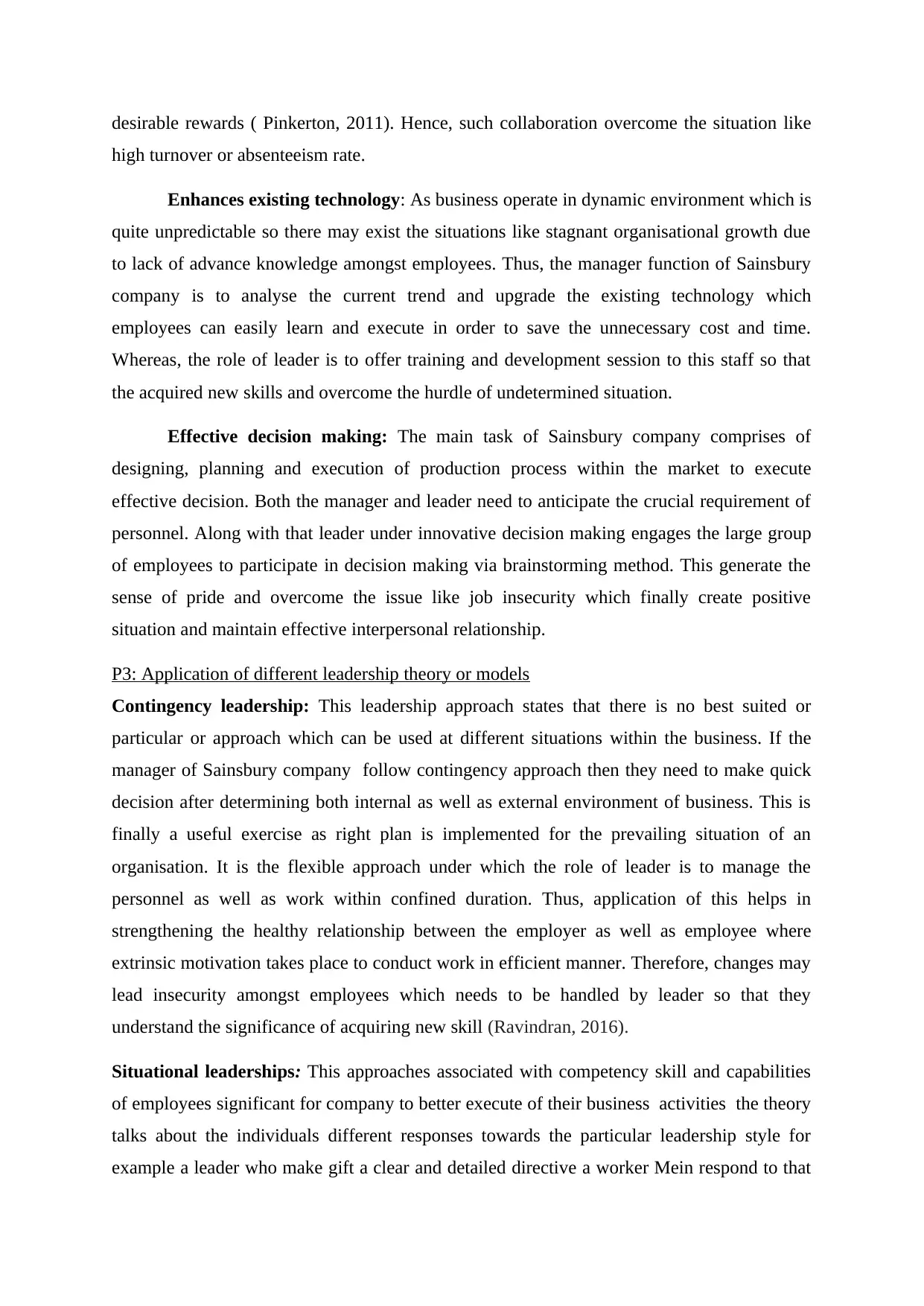
desirable rewards ( Pinkerton, 2011). Hence, such collaboration overcome the situation like
high turnover or absenteeism rate.
Enhances existing technology: As business operate in dynamic environment which is
quite unpredictable so there may exist the situations like stagnant organisational growth due
to lack of advance knowledge amongst employees. Thus, the manager function of Sainsbury
company is to analyse the current trend and upgrade the existing technology which
employees can easily learn and execute in order to save the unnecessary cost and time.
Whereas, the role of leader is to offer training and development session to this staff so that
the acquired new skills and overcome the hurdle of undetermined situation.
Effective decision making: The main task of Sainsbury company comprises of
designing, planning and execution of production process within the market to execute
effective decision. Both the manager and leader need to anticipate the crucial requirement of
personnel. Along with that leader under innovative decision making engages the large group
of employees to participate in decision making via brainstorming method. This generate the
sense of pride and overcome the issue like job insecurity which finally create positive
situation and maintain effective interpersonal relationship.
P3: Application of different leadership theory or models
Contingency leadership: This leadership approach states that there is no best suited or
particular or approach which can be used at different situations within the business. If the
manager of Sainsbury company follow contingency approach then they need to make quick
decision after determining both internal as well as external environment of business. This is
finally a useful exercise as right plan is implemented for the prevailing situation of an
organisation. It is the flexible approach under which the role of leader is to manage the
personnel as well as work within confined duration. Thus, application of this helps in
strengthening the healthy relationship between the employer as well as employee where
extrinsic motivation takes place to conduct work in efficient manner. Therefore, changes may
lead insecurity amongst employees which needs to be handled by leader so that they
understand the significance of acquiring new skill (Ravindran, 2016).
Situational leaderships: This approaches associated with competency skill and capabilities
of employees significant for company to better execute of their business activities the theory
talks about the individuals different responses towards the particular leadership style for
example a leader who make gift a clear and detailed directive a worker Mein respond to that
high turnover or absenteeism rate.
Enhances existing technology: As business operate in dynamic environment which is
quite unpredictable so there may exist the situations like stagnant organisational growth due
to lack of advance knowledge amongst employees. Thus, the manager function of Sainsbury
company is to analyse the current trend and upgrade the existing technology which
employees can easily learn and execute in order to save the unnecessary cost and time.
Whereas, the role of leader is to offer training and development session to this staff so that
the acquired new skills and overcome the hurdle of undetermined situation.
Effective decision making: The main task of Sainsbury company comprises of
designing, planning and execution of production process within the market to execute
effective decision. Both the manager and leader need to anticipate the crucial requirement of
personnel. Along with that leader under innovative decision making engages the large group
of employees to participate in decision making via brainstorming method. This generate the
sense of pride and overcome the issue like job insecurity which finally create positive
situation and maintain effective interpersonal relationship.
P3: Application of different leadership theory or models
Contingency leadership: This leadership approach states that there is no best suited or
particular or approach which can be used at different situations within the business. If the
manager of Sainsbury company follow contingency approach then they need to make quick
decision after determining both internal as well as external environment of business. This is
finally a useful exercise as right plan is implemented for the prevailing situation of an
organisation. It is the flexible approach under which the role of leader is to manage the
personnel as well as work within confined duration. Thus, application of this helps in
strengthening the healthy relationship between the employer as well as employee where
extrinsic motivation takes place to conduct work in efficient manner. Therefore, changes may
lead insecurity amongst employees which needs to be handled by leader so that they
understand the significance of acquiring new skill (Ravindran, 2016).
Situational leaderships: This approaches associated with competency skill and capabilities
of employees significant for company to better execute of their business activities the theory
talks about the individuals different responses towards the particular leadership style for
example a leader who make gift a clear and detailed directive a worker Mein respond to that
⊘ This is a preview!⊘
Do you want full access?
Subscribe today to unlock all pages.

Trusted by 1+ million students worldwide
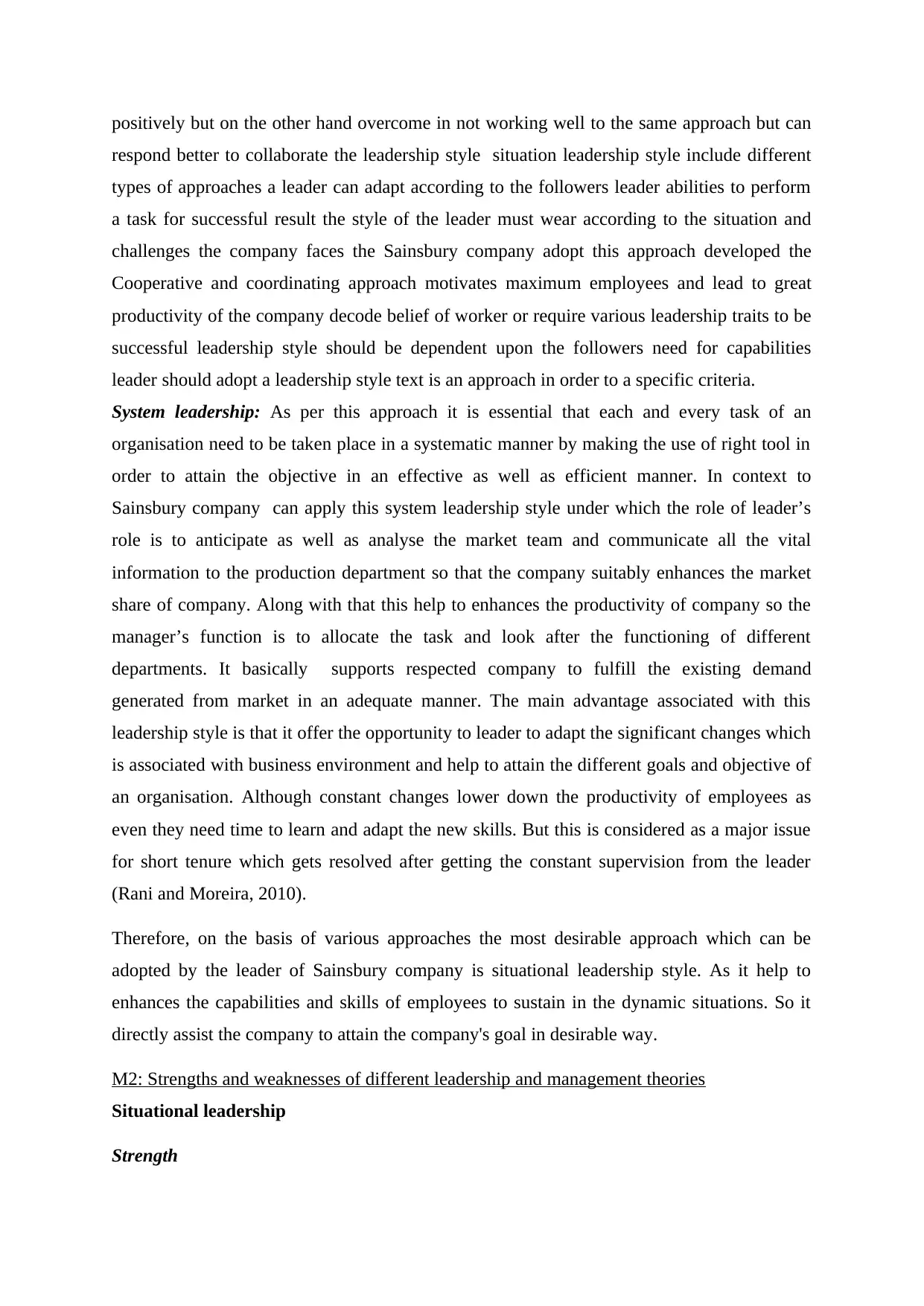
positively but on the other hand overcome in not working well to the same approach but can
respond better to collaborate the leadership style situation leadership style include different
types of approaches a leader can adapt according to the followers leader abilities to perform
a task for successful result the style of the leader must wear according to the situation and
challenges the company faces the Sainsbury company adopt this approach developed the
Cooperative and coordinating approach motivates maximum employees and lead to great
productivity of the company decode belief of worker or require various leadership traits to be
successful leadership style should be dependent upon the followers need for capabilities
leader should adopt a leadership style text is an approach in order to a specific criteria.
System leadership: As per this approach it is essential that each and every task of an
organisation need to be taken place in a systematic manner by making the use of right tool in
order to attain the objective in an effective as well as efficient manner. In context to
Sainsbury company can apply this system leadership style under which the role of leader’s
role is to anticipate as well as analyse the market team and communicate all the vital
information to the production department so that the company suitably enhances the market
share of company. Along with that this help to enhances the productivity of company so the
manager’s function is to allocate the task and look after the functioning of different
departments. It basically supports respected company to fulfill the existing demand
generated from market in an adequate manner. The main advantage associated with this
leadership style is that it offer the opportunity to leader to adapt the significant changes which
is associated with business environment and help to attain the different goals and objective of
an organisation. Although constant changes lower down the productivity of employees as
even they need time to learn and adapt the new skills. But this is considered as a major issue
for short tenure which gets resolved after getting the constant supervision from the leader
(Rani and Moreira, 2010).
Therefore, on the basis of various approaches the most desirable approach which can be
adopted by the leader of Sainsbury company is situational leadership style. As it help to
enhances the capabilities and skills of employees to sustain in the dynamic situations. So it
directly assist the company to attain the company's goal in desirable way.
M2: Strengths and weaknesses of different leadership and management theories
Situational leadership
Strength
respond better to collaborate the leadership style situation leadership style include different
types of approaches a leader can adapt according to the followers leader abilities to perform
a task for successful result the style of the leader must wear according to the situation and
challenges the company faces the Sainsbury company adopt this approach developed the
Cooperative and coordinating approach motivates maximum employees and lead to great
productivity of the company decode belief of worker or require various leadership traits to be
successful leadership style should be dependent upon the followers need for capabilities
leader should adopt a leadership style text is an approach in order to a specific criteria.
System leadership: As per this approach it is essential that each and every task of an
organisation need to be taken place in a systematic manner by making the use of right tool in
order to attain the objective in an effective as well as efficient manner. In context to
Sainsbury company can apply this system leadership style under which the role of leader’s
role is to anticipate as well as analyse the market team and communicate all the vital
information to the production department so that the company suitably enhances the market
share of company. Along with that this help to enhances the productivity of company so the
manager’s function is to allocate the task and look after the functioning of different
departments. It basically supports respected company to fulfill the existing demand
generated from market in an adequate manner. The main advantage associated with this
leadership style is that it offer the opportunity to leader to adapt the significant changes which
is associated with business environment and help to attain the different goals and objective of
an organisation. Although constant changes lower down the productivity of employees as
even they need time to learn and adapt the new skills. But this is considered as a major issue
for short tenure which gets resolved after getting the constant supervision from the leader
(Rani and Moreira, 2010).
Therefore, on the basis of various approaches the most desirable approach which can be
adopted by the leader of Sainsbury company is situational leadership style. As it help to
enhances the capabilities and skills of employees to sustain in the dynamic situations. So it
directly assist the company to attain the company's goal in desirable way.
M2: Strengths and weaknesses of different leadership and management theories
Situational leadership
Strength
Paraphrase This Document
Need a fresh take? Get an instant paraphrase of this document with our AI Paraphraser
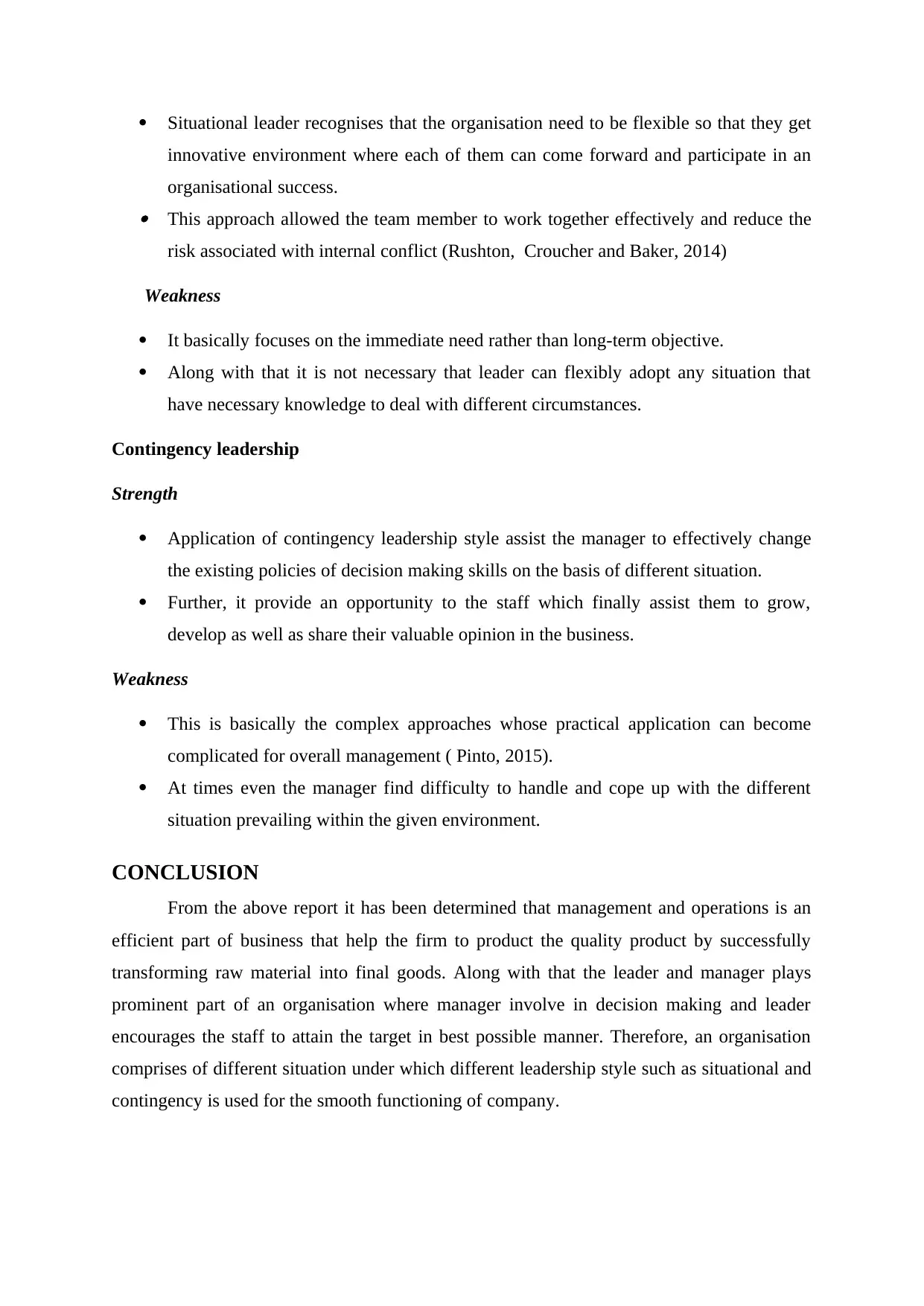
Situational leader recognises that the organisation need to be flexible so that they get
innovative environment where each of them can come forward and participate in an
organisational success. This approach allowed the team member to work together effectively and reduce the
risk associated with internal conflict (Rushton, Croucher and Baker, 2014)
Weakness
It basically focuses on the immediate need rather than long-term objective.
Along with that it is not necessary that leader can flexibly adopt any situation that
have necessary knowledge to deal with different circumstances.
Contingency leadership
Strength
Application of contingency leadership style assist the manager to effectively change
the existing policies of decision making skills on the basis of different situation.
Further, it provide an opportunity to the staff which finally assist them to grow,
develop as well as share their valuable opinion in the business.
Weakness
This is basically the complex approaches whose practical application can become
complicated for overall management ( Pinto, 2015).
At times even the manager find difficulty to handle and cope up with the different
situation prevailing within the given environment.
CONCLUSION
From the above report it has been determined that management and operations is an
efficient part of business that help the firm to product the quality product by successfully
transforming raw material into final goods. Along with that the leader and manager plays
prominent part of an organisation where manager involve in decision making and leader
encourages the staff to attain the target in best possible manner. Therefore, an organisation
comprises of different situation under which different leadership style such as situational and
contingency is used for the smooth functioning of company.
innovative environment where each of them can come forward and participate in an
organisational success. This approach allowed the team member to work together effectively and reduce the
risk associated with internal conflict (Rushton, Croucher and Baker, 2014)
Weakness
It basically focuses on the immediate need rather than long-term objective.
Along with that it is not necessary that leader can flexibly adopt any situation that
have necessary knowledge to deal with different circumstances.
Contingency leadership
Strength
Application of contingency leadership style assist the manager to effectively change
the existing policies of decision making skills on the basis of different situation.
Further, it provide an opportunity to the staff which finally assist them to grow,
develop as well as share their valuable opinion in the business.
Weakness
This is basically the complex approaches whose practical application can become
complicated for overall management ( Pinto, 2015).
At times even the manager find difficulty to handle and cope up with the different
situation prevailing within the given environment.
CONCLUSION
From the above report it has been determined that management and operations is an
efficient part of business that help the firm to product the quality product by successfully
transforming raw material into final goods. Along with that the leader and manager plays
prominent part of an organisation where manager involve in decision making and leader
encourages the staff to attain the target in best possible manner. Therefore, an organisation
comprises of different situation under which different leadership style such as situational and
contingency is used for the smooth functioning of company.

⊘ This is a preview!⊘
Do you want full access?
Subscribe today to unlock all pages.

Trusted by 1+ million students worldwide
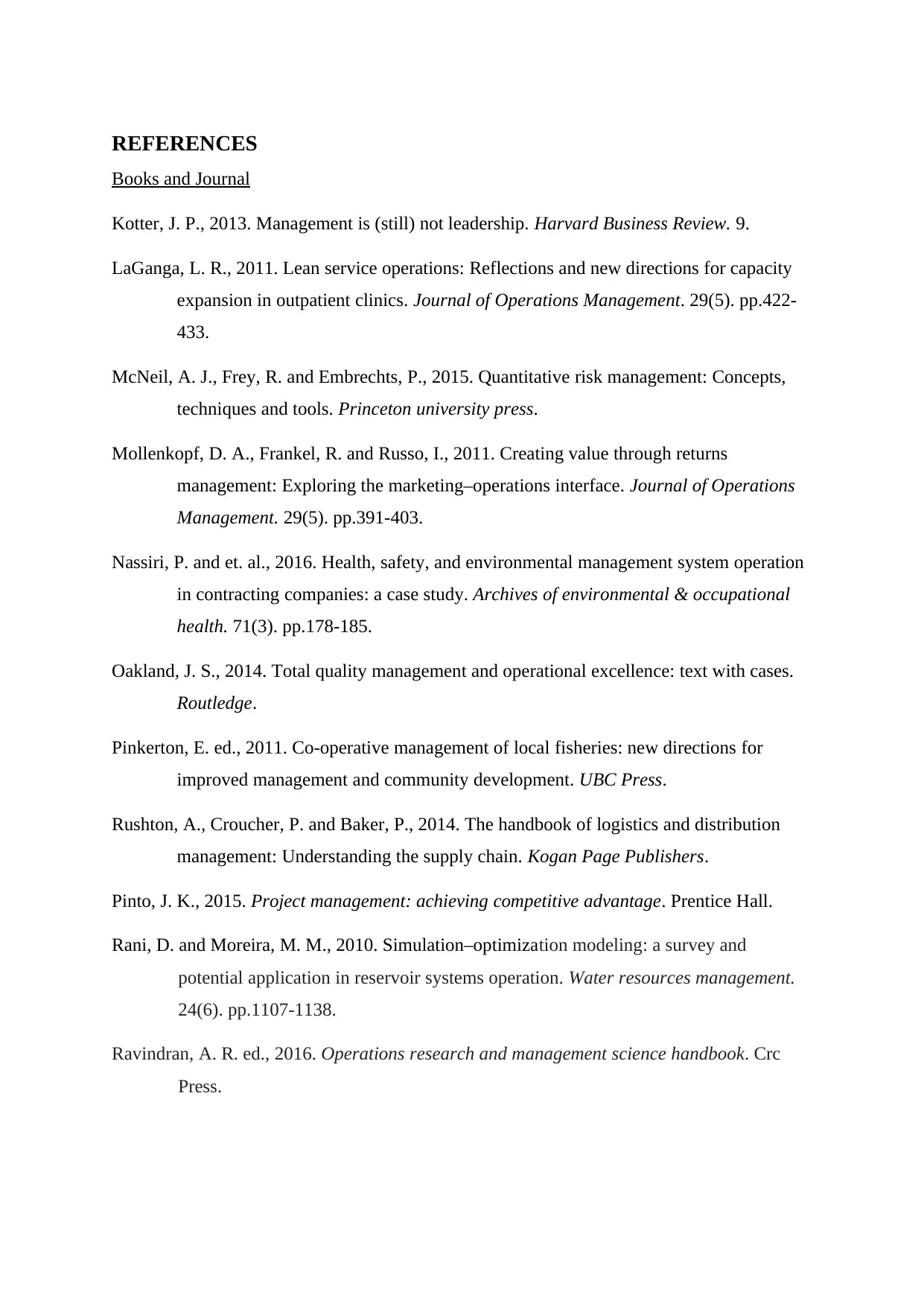
REFERENCES
Books and Journal
Kotter, J. P., 2013. Management is (still) not leadership. Harvard Business Review. 9.
LaGanga, L. R., 2011. Lean service operations: Reflections and new directions for capacity
expansion in outpatient clinics. Journal of Operations Management. 29(5). pp.422-
433.
McNeil, A. J., Frey, R. and Embrechts, P., 2015. Quantitative risk management: Concepts,
techniques and tools. Princeton university press.
Mollenkopf, D. A., Frankel, R. and Russo, I., 2011. Creating value through returns
management: Exploring the marketing–operations interface. Journal of Operations
Management. 29(5). pp.391-403.
Nassiri, P. and et. al., 2016. Health, safety, and environmental management system operation
in contracting companies: a case study. Archives of environmental & occupational
health. 71(3). pp.178-185.
Oakland, J. S., 2014. Total quality management and operational excellence: text with cases.
Routledge.
Pinkerton, E. ed., 2011. Co-operative management of local fisheries: new directions for
improved management and community development. UBC Press.
Rushton, A., Croucher, P. and Baker, P., 2014. The handbook of logistics and distribution
management: Understanding the supply chain. Kogan Page Publishers.
Pinto, J. K., 2015. Project management: achieving competitive advantage. Prentice Hall.
Rani, D. and Moreira, M. M., 2010. Simulation–optimization modeling: a survey and
potential application in reservoir systems operation. Water resources management.
24(6). pp.1107-1138.
Ravindran, A. R. ed., 2016. Operations research and management science handbook. Crc
Press.
Books and Journal
Kotter, J. P., 2013. Management is (still) not leadership. Harvard Business Review. 9.
LaGanga, L. R., 2011. Lean service operations: Reflections and new directions for capacity
expansion in outpatient clinics. Journal of Operations Management. 29(5). pp.422-
433.
McNeil, A. J., Frey, R. and Embrechts, P., 2015. Quantitative risk management: Concepts,
techniques and tools. Princeton university press.
Mollenkopf, D. A., Frankel, R. and Russo, I., 2011. Creating value through returns
management: Exploring the marketing–operations interface. Journal of Operations
Management. 29(5). pp.391-403.
Nassiri, P. and et. al., 2016. Health, safety, and environmental management system operation
in contracting companies: a case study. Archives of environmental & occupational
health. 71(3). pp.178-185.
Oakland, J. S., 2014. Total quality management and operational excellence: text with cases.
Routledge.
Pinkerton, E. ed., 2011. Co-operative management of local fisheries: new directions for
improved management and community development. UBC Press.
Rushton, A., Croucher, P. and Baker, P., 2014. The handbook of logistics and distribution
management: Understanding the supply chain. Kogan Page Publishers.
Pinto, J. K., 2015. Project management: achieving competitive advantage. Prentice Hall.
Rani, D. and Moreira, M. M., 2010. Simulation–optimization modeling: a survey and
potential application in reservoir systems operation. Water resources management.
24(6). pp.1107-1138.
Ravindran, A. R. ed., 2016. Operations research and management science handbook. Crc
Press.
1 out of 10
Related Documents
Your All-in-One AI-Powered Toolkit for Academic Success.
+13062052269
info@desklib.com
Available 24*7 on WhatsApp / Email
![[object Object]](/_next/static/media/star-bottom.7253800d.svg)
Unlock your academic potential
Copyright © 2020–2025 A2Z Services. All Rights Reserved. Developed and managed by ZUCOL.





